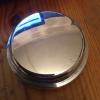I guess it reads like an argument is brewing but Im not arguing at all, you are entirely correct.
As long as people are sensible, there is no reason not to make a custom loom. Common sense, a reasonable knowledge of vehicle electrics and a little basic physics is enough to see anyone through. Using the wrong wiring will very probably end in tears, or flames. I did mine for around the £50 mark, which IMO is much preferable to paying £100+ for a replacement standard loom. Granted, it took a littlefore-thought, but IMO the end result is better.
A basic equation allows anyone to work out current draw. amps = power / volts. So, taking mainbeam headlights as an example, each unit is rated at 60w so 120w in total. 120w divided by 12v gives a current draw of 10 amps. Obviously, using wiring rated at 11 amps is cutting it way too fine, I think my lighting stuff is rated at 25 amps, which gives a massive safety zone. A fuse rated to blow at 15 amps allows plenty current to flow, allows for surges on start-up, wont overheat, and will blow long before the wire starts to suffer.
I have every electrical item in my mini (81 van so nothing too fancy electrics-wise) on a seperate dedicated circuit with its own fuse and its own earth point if required. Its not as daunting as it sounds.... LT ignition, dip beams, main beams and fog light, side/tails, brake lights, instrument panel, stereo, heater blower, wiper motor with screenwash pump, indicators and hazards - its not a lot of circuits really, especialy compared to a more modern car.
I have 10 fuses covering the whole lot, and wher there are more than two things from the same fuse, they are not safey-critical (ie a short in the interior light wont kill the ignition or the brake lights or something silly like that) Each circuits wiring is chosen to give a decent safety margin over what the circuit should draw as normal. Most stuff only draws a few amps anyway, so not much requires the heavier wiring.
I have an intense dislike of the standard minis loom. Im certainly not any kind of expert, but from my amateur viewpoint, its a very flawed design. I dislike the way so many unrelated items run from the same fuse, meaning a failure can knock out completely unrelated circuits at the same time. I dislike the less than waterproof fusebox mounted in the engine bay exposed to damp, I DETEST the non-weatherproofed bullet connectors that split the loom to the front lights, located right behind the grill in the line of spray. I find the looms routing to be needlessly complicated too.
Mine is routed differently from standard and mostly hidden. The fuse boxes are on the right hand side of the dashboard. two heavy feeds come from the battery (behind the seats) one to some of the fuses that are permanantly live, the other through the ignition switch and back to the fuses, giving power to the required fuses depending on the ignition switch position. A section runs along the dash rail to the switches and central instruments, and on to the column switches. the rear lights are all run via a heavy multi-core trailer cable which runs along the floor to the rear. Another section of loom goes through the bulkhead behind the fusebox and into the space under the wing, where smaller feeds go through the inner wing to the wipers and other things at the backof the engine bay. Everything else runs down behind the inner wing and along the inside of the front panel, and pops up where required for the headlights etc, and the engine wiring. The main cable to the starter still runs under the floor as standard.




















